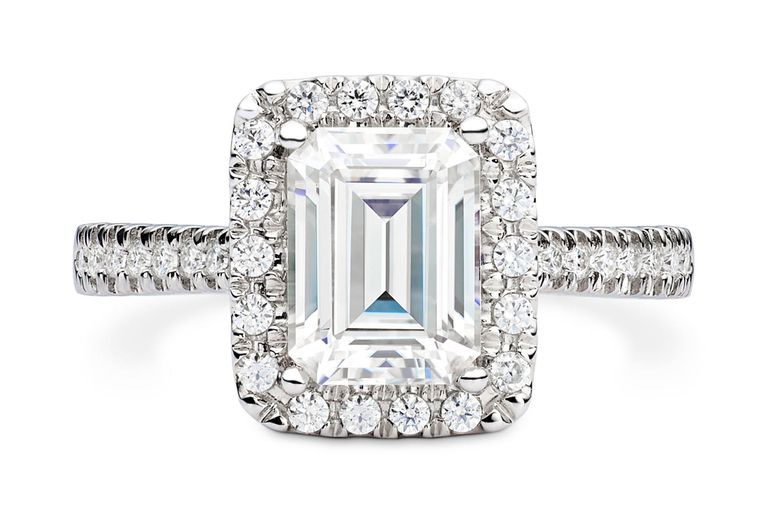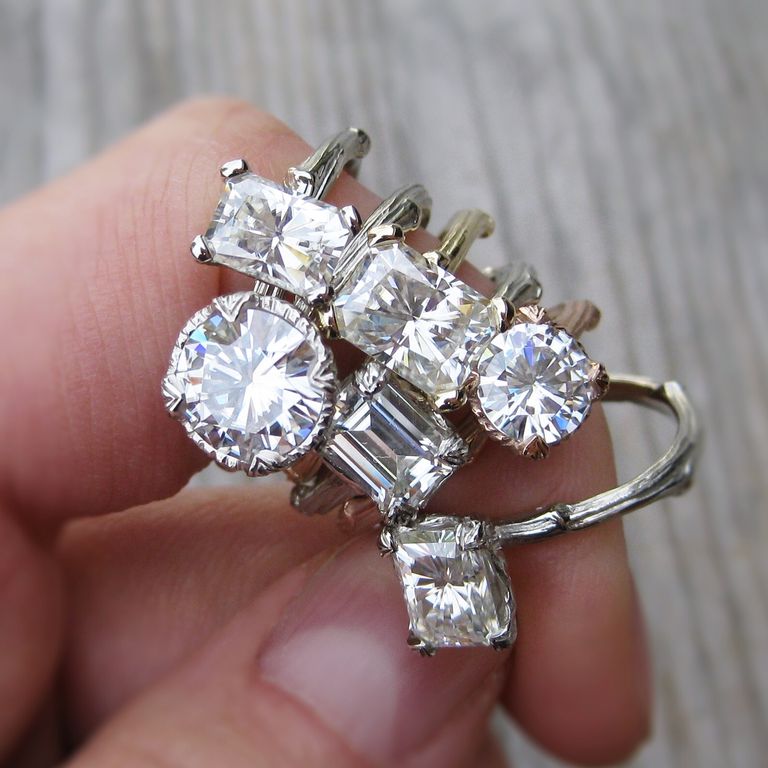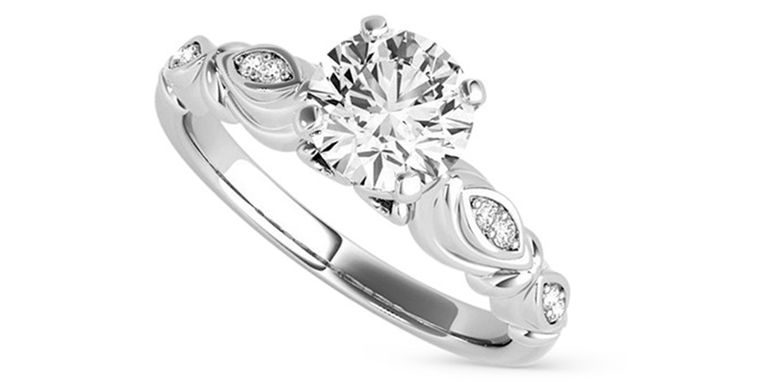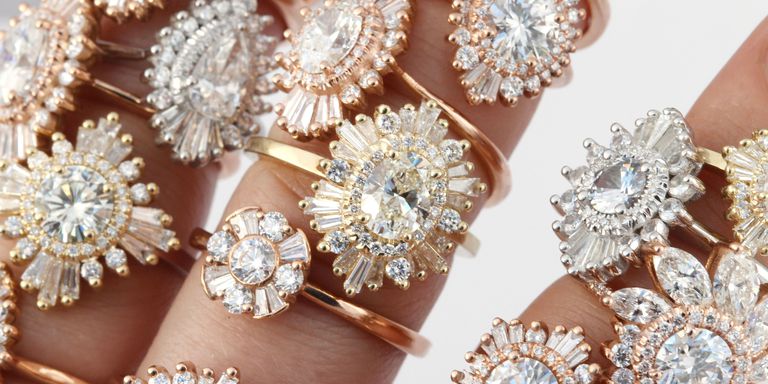Moissanite, a lab-created stone derived from outer space with similar properties to diamonds, is proving an affordable alternative to traditional engagement rings
We automatically associate engagement rings with the image of a diamond solitaire: sparkly, durable, highly valuable and hewn from the earth. Diamonds have a vast heritage; age-old, flecked with ethical complications, but they ultimately still resonate as the most-prized precious stones and therefore remain the favourite choice for wedding jewellery. If, however, you trawl Instagram for engagement ring inspiration, you might be confused to see similar-looking sparkle with the hashtag #moissanite. Meet the diamond alternative seducing the Millennial jewellery market: a laboratory-created stone that doesn’t require mining, has similar chemical properties to diamonds and is a fraction of the price.
Moissanite is colloquially referred to as a ‘space diamond’, because it was originally discovered in 1893 by the Nobel Prize-winning chemist Dr. Henri Moissan in the wake of a meteorite crash; it was initially mistaken for diamond particles due to its similar hardness and reflective qualities. The substance (silicon carbide) was then named after Moissan, who recognised the lucrative potential of being able to recreate it in a lab, producing sparkling stones on tap instead of disturbing the ground.
Fast forward to 2016, and Charles & Colvard (now the global leader in moissanite manufacturing) is reporting record sales, while independent jewellery designers using the diamond alternative are being inundated with requests for moissanite stones. Instagram and Etsy are now flooded with moissanite jewellery, YouTube has over 39,000 videos showing moissanites often side by side with diamonds, and while the popularity of the stone seems to be largely based in America at the moment, increasing numbers of mainstream UK retailers (including Debenhams) are introducing moissanite jewellery collections.

Courtesy of Charles & Colvard
So why the surge in interest? First of all, moissanite offers good value for money. A two-carat round diamond, depending on the quality and colour, could cost you in the region of £10,000 to £20,000, whereas a two-carat moissanite stone will set you back about $800 (about £560). Forever One, the latest range of moissanite produced by Charles & Colvard, is its first completely colourless stone that emulates the most precious gradings of diamonds, and is available in four different shapes. With the imminent addition of a fifth shape, the asscher cut, brides have a large option of stones to create imaginative designs, which they may not be able to afford using diamonds.
Heidi Gibson, a California-based jewellery designer, believes this affordability is crucial to the rising increase in moissanite’s popularity. “My clients find my designs because they are wanting a ring with a strong visual impact and don’t have the money for a five-carat solitaire,” says Gibson. “The moissanite in my designs is always paired with diamonds, so they feel that they have the best of both worlds: the ‘diamond ring’ without the huge price tag of the centre stone. They can buy a ring that appears to cost $20,000 for a fraction of the cost.”
Kristin Coffin, another jeweller working with the stone, is now selling more moissanite than diamond pieces. “Choosing moissanite really aligns with the values of this generation, because you can have a beautiful designer ring and still have money left over to take an amazing honeymoon or save for a home,” she says.

Courtesy of Kristin Coffin
“The perception of man-made stones is changing at lightning speed,” says Sarah Williams, the vice-president of marketing and branding at Charles & Colvard. “Two years ago, the concept of man-made gemstones took a great deal of explanation and faced consumer resistance, but now the number of companies getting into the lab-created gemstone and diamond market is on the rise.” Swarovski has just launched its own fine-jewellery line, Diama, using their new Created Diamonds. These are stones that have all the essential qualities of a diamond, but are from a lab and not the earth, avoiding the environmental and societal issues attached to mined diamonds. There are many other man-made diamond labs springing up, including the Silicon Valley-based Diamond Foundry, which Leonardo DiCaprio famously invested in last year.
ADVERTISEMENT – CONTINUE READING BELOW
Diamond retailers, however, are naturally sceptical. “I think that long term, regardless of the visual similarity, the concept of a laboratory-made stone for fine jewellery with such a strong sentimental value is crass,” says David Allen, of the online diamond retailer 77 Diamonds. “The lack of natural production removes the mystique of a one-of-a-kind stone formed over billions of years, which in truth is part of the magic of a diamond.” The environmental impact of diamond mining has also greatly improved in recent years, with mines and brands working hard to reduce any ethical or environmental drawbacks, so this argument in favour of simulated stones is not as strong as it might have once been.
Gibson, on the other hand, thinks that there does not need to be a stand-off between diamonds and moissanite. “I believe that if a client really wants a diamond because it is a diamond, they are going to buy a diamond,” she says. “Moissanite does not have the same romantic history of a natural stone that the earth created over many thousands of years,” she continues. “At the same time, however, it does not have the same potential ‘stigma’ of a diamond. So I’d say that there is an audience for both, and moissanite should be embraced.”
“Smart jewellers know that there is a customer for both,” agrees Williams. It seems likely that those who have already bought diamonds might be reluctant to choose a man-made stone, but Millenials making their first foray into the jewellery market may be more open-minded to diamond alternatives. “Society absorbed decades of diamond marketing, so it can be tough to shift our attitude to include alternatives,” says Coffin. “It may take some time before we see a total attitude shift, but moissanite has the qualities we all love, so it will continue to build momentum.”

Courtesy of Charles & Colvard
Source: https://www.harpersbazaar.com/uk/bazaar-brides/news/a37311/introducing-space-diamonds-why-you-might-want-a-moissanite-engagement-ring/
By: Charlie Boyd

